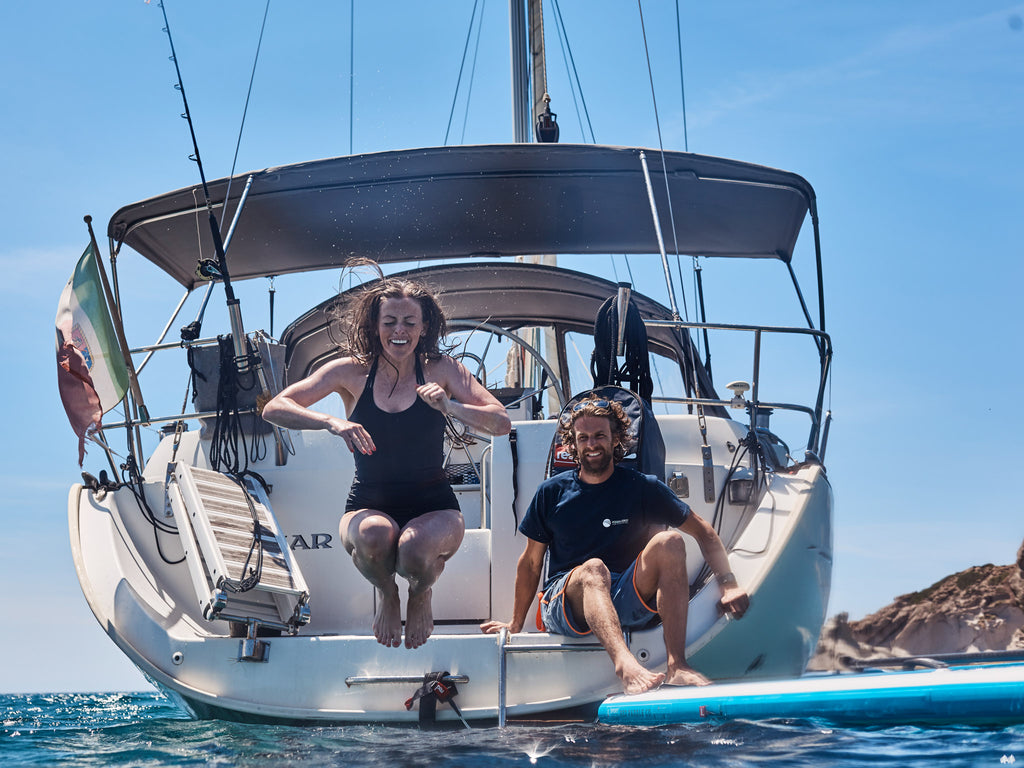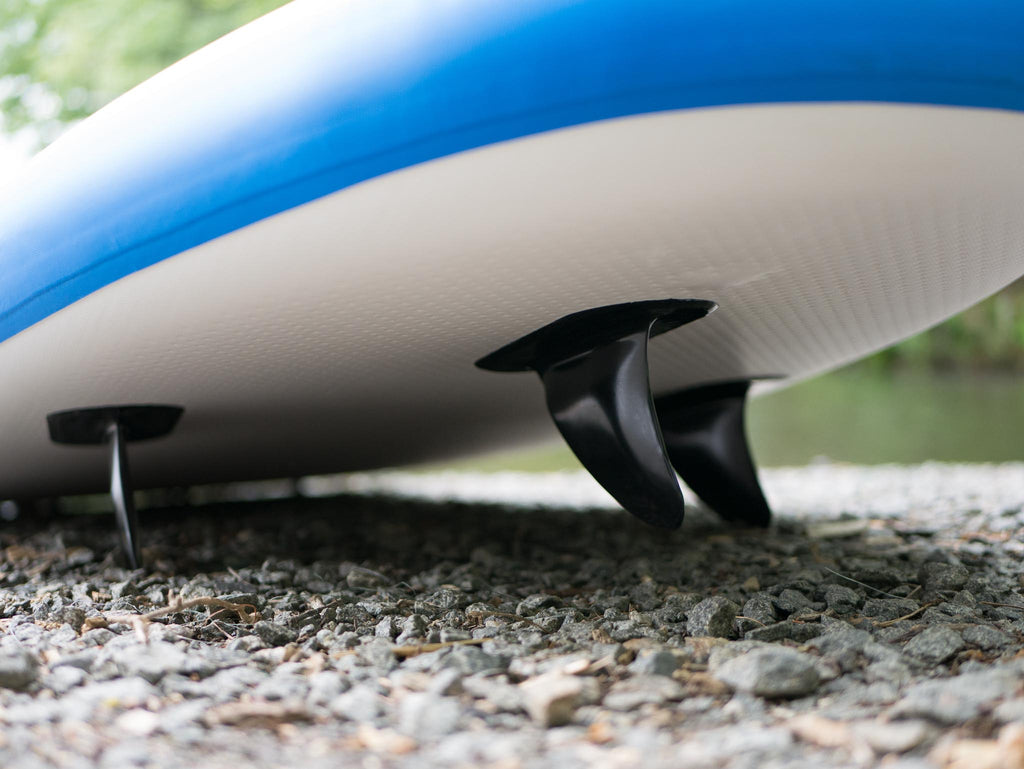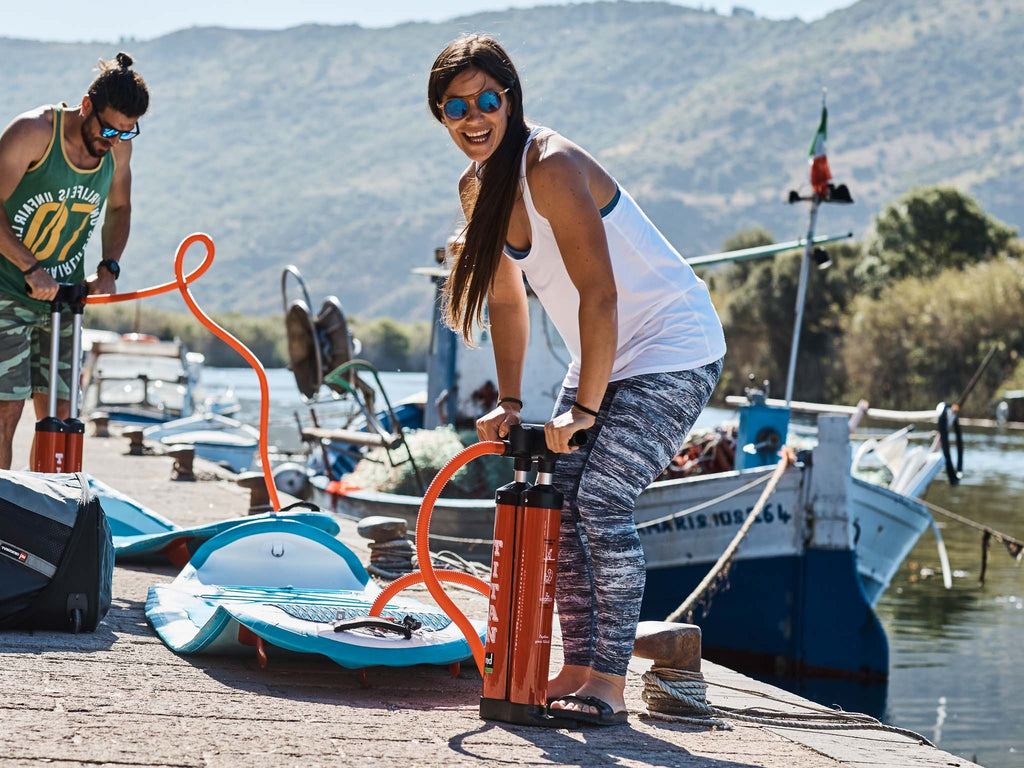
How To Buy An Inflatable Paddle Board (2024 Buying Guide)
As we enter 2024, inflatable paddle board buyers are faced with an overwhelming number of confusing choices. The market is flooded with cheap paddle boards, with new brands springing up seemingly overnight to take advantage of the popularity of what is the fastest-growing water sport.
Many online sellers, marketplaces and brands have mastered the art of misinformation, making false claims about products and generating social proof of their success with fake customer reviews or paid-for “expert” reviews by people who know very little about stand up paddle boarding.
This Inflatable Paddle Board Buyer’s Guide is meant to break through the fog and shed light on specific technical factors that will help you sort out the differences between boards and make an informed purchasing decision.
For readers who are new to paddle boarding, we’ll start with some basic information on board types and uses. Readers who already know the basics may want to skip forward to sections on fin systems, board construction, and deck riggings, which are technical factors that are important when comparing boards for purchase.
You will also find information on the vital accessories, including pumps, paddles, personal flotation devices, and leashes that you’ll be using with your new inflatable paddle board.
For guidance on how to approach the task of shopping for an inflatable paddle board, we also recommend that you read about our step-by-step guide to the buying process in The Best Inflatable Paddle Board - Reality vs the Internet

Board Categories
If you are just getting into paddleboarding, you will likely want to look for an all-around inflatable SUP that will do many things well and let you explore different venues and types of paddling.
If you have some experience in SUP or other board sports and want to go fast, you may want to look in the sport/performance board board category.
If avoiding falling and increasing your confidence as you learn is a priority, you’ll want to shop for an ultra-stable inflatable SUP board.
If you are purchasing for a specific type of paddleboarding, there are specific boards tailored to specific uses. You can choose from boards designed for SUP surfing, boards ideal for SUP Yoga, whitewater SUP boards, boards for SUP touring, or even a racing SUP. You may be looking for a SUP board for your kids, or a SUP board for specialized use, such as fishing, windsurfing, or group paddling. Knowing the category of board you are looking for is the first step to narrowing down your choices.

Brand Selection
Brands often specialize in a particular category of inflatable SUP Board, so you can narrow down your choices by limiting your search to brands that are strong in the category you have zeroed in on
There are a plethora of brands to choose from, but in our store, we always focus on a small selection of brands that stand out for build quality, design, and customer support.
Earth River SUP focuses on all-around inflatable paddle boards that multitask and perform well in multiple paddling environments, including lakes, rivers, and coastal waters.
Red Paddle Co runs the gamut of board types with a broad selection of boards, some of which are very specialized for particular uses such as racing or surfing.
NRS and Hala SUP specialize mostly in whitewater-specific models.
Starboard SUP crosses over from its windsurfing background and has a SUP line with a variety of hard and inflatable boards oriented toward surfing and racing.
Fanatic are decent boards for the those on a budget and seeking a board for casual SUP use.
Naish are also geared toward touring and racing crossover boards though have a few value orientated all around SUP boards in their range.
Brands will overlap in various categories, but this gives a good starting point for approaching their product lines.
There are dozens of other brands on the market, but the majority of them are cranking out mediocre boards that do not have any real distinguishing features or advantages. Many boards that are marketed with a lot of hype and fanfare are made with flimsy constructions, despite marketing claims to the contrary.
Impressive sounding terms such as “military-grade” and “4-layer” are thrown around with almost complete disregard for the reality of the compromises that were made to cheapen the boards and then repeated ad nauseam by the social influencer / paid marketing machine.
Clearance or Open Box Models
Buyers on strict budgets don’t need to rule out quality brands. Many paddle boarders like to be on the newest models and sell their quality inflatable SUP boards so they can buy a newer one for the next season.
A well maintained used board that meets all your criteria can be an attractive option to some cheaper single layer inflatable SUP boards sold at Costco or on Amazon, though unless you know the buyer personally, a used board can be a case of inheriting someone else's problems. Another thing to note is that warranties are often not transferable so it is another area to apply due diligence.
You can find great deals on high-end boards if you buy them on clearance at the end of the season or after a model change in our SUP Deals and Clearance section. High end brands usually implement incremental changes so a previous seasons model will still be a great investment.
Open box boards are another opportunity to purchase a quality SUP at a significant discount though availability can be sparse. We will often sell boards that have been used for display for event or that we have used for on water testing, though demand can be very high for some models.
Generally it makes sense to purchase the best board you can afford, with a clear plan on the paddling activities you intend to pursue.

Board Size and Shape Considerations
After you have chosen a board type category and narrowed down to a manageable list of brands, you will still need to decide which board are best for your unique needs.
In general terms, larger paddlers should paddle larger boards, but a lot depends on the skills and preferences of the individual. While there are many nuances to board shape and size considerations, here are some general principles to get you started on understanding how a board’s size and shape affect its performance:
- A longer board will have more glide than a shorter one.
- A narrower board will be faster than a wider board
- A wider board will be more stable than a narrower board.
- Boards that are wider at the tail will be more stable than boards with a narrow tail.
- Boards with a narrow tail will turn more quickly during surfing maneuvers
- Thicker boards support more weight than thinner boards but there are serious disadvantages to an excessively thick board.
- Thinner boards feel more stable than thicker boards when supporting the correct amount of weight.
These generalizations can help you narrow down your choices so you can focus on the detailed specifications of the boards that meet your basic criteria. For more details on board sizing, check out our article What Size SUP Board is Right For You?

Materials and Construction
There are vast differences in the materials and construction methods used in inflatable paddle boards. It is important to understand some basic aspects of the construction of any board you are considering.
Boards made with a single layer of material will tend to be light and inexpensive and are usually made thicker (6 inches typically) to compensate for the low inherent rigidity of the material. Some lightweight boards are made with a “fusion” construction which has additional reinforcement in the material that keeps the weight low but still has good durability and stiffness for most paddling environments.
Note that "fusion construction" has been thrown around a lot of late, and be aware that there are different types of material claimed to be 'fusion' material. The brands we carry all use the highest grade fusion materials but the same cannot be said for many cut-price boards who are generally just using a single layer construction under the guise of 'fusion' material.
The most rugged (and more expensive) build is dual layer, which has a second layer of reinforced PVC fabric bonded to the main layer. Dual layer is becoming less common due to higher manufacturing cost and general consumer preference for lighter boards, but the extra layer adds much to a board’s durability and the extra 3-4 lb of weight that a second layer adds can improve performance in more demanding paddling conditions where you want the board to carry some momentum.
Related: How Much Do Inflatable Paddle Boards Cost?

Dual-layer construction increases board rigidity and durability for more challenging environments.
Deck Pad and Riggings
A quality deck pad can make all the difference in your comfort while paddling, which in turn may keep you out on the water longer enjoying the outdoor experience.
Deck pads vary greatly in material thickness and density and are made with a variety of textures that affect how much grip the deck will have and how it feels underfoot. Higher end boards may have a kick tail with a raised back edge and an arch bar for locating your back foot while doing maneuvers in surfer stance. Be sure to consider deck pad features when comparing boards.

A kicktail with arch bar is an upgrade feature that assists with pivot turns, tail drops and surfing maneuvers.
You should also consider the layout of D-rings and bungee tie downs on the board. You’ll want enough riggings to secure the basic items you will be bringing on the board with you, but watch out for unnecessary attachments that add weight and might get in the way of your footwork or snag on objects in the water.
The configuration that seems most time-tested and effective is a single crisscross bungee system near the nose of the board, a centered D-ring at the nose for towing, and another centered D-ring at the tail for attaching a leash.
Beyond that, we urge you to question the usefulness of extra accessories and attachments and consider whether they will help you more than they will get in the way while you are paddling or transporting the board.

With deck riggings, quality and positioning are much more important than quantity. Look for stainless steel D-rings and sensible bungee layouts that don’t clutter the deck and interfere with footwork, unless you are buying specifically for long expedition paddling.
The Important Fin System Choice
Fins have a profound impact on the performance and versatility of a SUP board and are an area where buyers are most likely to make a mistake if they don’t understand what they are buying.
Configurable Fin System
Paddlers wanting the ability to modify and tune their board’s performance can now opt for a fully configurable fin system with removable and interchangeable fins in the center and side positions. Having all fins interchangeable opens a lot of possibilities.
You can ride the board with only a tall center fin when speed is a priority. You can use a large center fin and two smaller side fins when you want additional lateral stability, for example in currents or windy conditions.
If you’re going out in shallow water, you can put in a shorter center fin. or you can take out the center fin entirely and use only the two side fins to help you clear obstacles and keep the board agile.

A configurable fin system uses surfing industry standardized fin boxes, allowing you to adapt your SUP for different environments and tune its performance for various uses.
A fully configurable fin system that can accept a variety of center and side fins in different sizes and shapes adds significantly to the manufacturing cost of board, so they are relatively hard to find, but well worth it if you want the performance and flexibility that they add to your setup. An example of a well-executed configurable fin system is the Earth River SUP Lake - River - Coast configuration.
Permanent Fin System
Paddlers who value simplicity and carefree use of their equipment will be best served by a permanent tri-fin system, which has three equally sized unbreakable fins that are permanently attached to the board.
The setup divides the fin area equally among the three fins and results in the total depth of the fins being much less than a tall center fin in the more typical setup. Having only 4 inches of fin depth comes in very handy when paddling over rocks or other objects in shallow water, where some of the most interesting exploring opportunities will be found.

Permanent unbreakable fins eliminate the possibility of forgetting fins, or losing fins while out paddling. Permanent fin setups typically require less care and setup than a configurable fin system.
Entry Level Basic Fin System
The most typical fin setup on entry-level paddle boards has two very shallow permanent fins on the sides and a single large removable fin in the center. Boards with this basic fin system can perform adequately in non-challenging conditions, such as on a lake with ample depth on a calm day, but fall short when you want to explore areas with shallow water, go out in currents or rougher waters, or alter the board’s performance to your liking.
SUP Accessories You Will Need
The main accessories required for every SUP session are a paddle, pump or inflator, a personal floatation device and a SUP leash.
The SUP Paddle
After the board itself, the paddle is the accessory that will have the greatest impact on your comfort and effectiveness while paddling. For this reason, we recommend that you put almost as much thought into choosing a paddle as you do for the board itself. The main things you need to consider when choosing a paddle are
- The design of the handle
- Convenience and reliability of the length adjusting system
- Shaft construction
- Blade design
- The materials used in constructing the paddle
- Perhaps most importantly, the overall weight of the paddle
Because of the importance of a good paddle to your overall paddling experience, we have written a detailed article on how to choose a SUP paddle, which you should read in its entirety before settling on a SUP board package to buy.

Features to look for in a paddle include a smooth molded handle, convenient and reliable length adjuster, true carbon shaft, and a lightweight blade.
Pump or Inflator
Every inflatable paddle board will come with a manual pump, but they vary considerably in their quality and ease of inflation.
The most basic type of manual pump has a single cylinder and moves air into the board only while pushing down on the handle. With this type of pump, pulling the handle back up to the starting position is done with no resistance but does not contribute to inflating the board. A more effective manual pump design has a “dual action” which means it moves air into the board on the upstroke as well as the downstroke.
A dual-action pump can cut your inflation time almost in half.

A dual-action pump moves air on both the downstroke and upstroke, reducing inflation time and effort.
Another type of pump has two cylinders instead of one, so it can move a lot of air at the outset, but one of the cylinders needs to be disabled when the pressure in the board increases and pumping becomes difficult.
The downside of two-cylinder pumps is that they are bulky and heavy, so they reduce the overall portability and compactness of your inflatable SUP kit.

Double-barrel manual pumps can move a lot of air during the low-pressure phase of pumping, but are less portable than dual-action single cylinder pumps which offer similar performance advantages.
For manual pumping, we much prefer a single-cylinder dual-action pump, as it inflates a board in the same amount of time as a two-cylinder pump without the extra bulk and weight. You won’t be able to choose what type of pump comes with a particular board, so you need to consider the choice that the manufacturer made in your overall evaluation and comparison of inflatable SUP kits.
While the design of the manual pump can make inflation a little bit faster and easier, the best way to deal with manual pumping is to avoid it altogether.
A 12-volt electric SUP inflator, which can be powered by your car accessory/lighter socket or a specifically designed portable power source, is a purchase you will always be glad you made once you have experienced manual pumping.

It is often said that pumping up your board is a good warm-up for paddling, but this is really just rationalization.
You’ll have a much more enjoyable experience if you use an electric pump to get your board inflated and save your warm-up for on the water. Just be sure to get an electric pump with a good track record of reliability, as there are some cheap SUP inflators on the market that don’t hold up in repeated use and and give electric inflators an undeserved bad reputation.
Life Jacket / Personal Floatation Device (PFD)
A not very glamorous, but truly essential component of your SUP kit is a personal flotation device (PFD), which is important for your personal safety and required by law on many lakes and waterways where you may want to paddle.
There are two main types of PFD: A lifejacket or inflatable belt pack. A lifejacket is the safer option, but many paddlers want the feeling of being out on the water unconstrained by anything worn on their torso.
An inflatable belt pack is worn inconspicuously around your waist and has a CO2 cylinder which is activated by pulling on a string. Pulling the cord inflates a bladder that is folded inside the belt pack for flotation in an emergency situation.

There are situations where an inherently buoyant lifejacket is the only option, such as whitewater paddling, and a lifejacket is really the only safe choice for kids, beginners, and paddlers who are not strong swimmers. A belt pack can be a valid choice for adults with good swimming skills while paddling on flat water, and is in fact the most popular type of PFD that we sell.
The one situation where paddling without a PFD is generally accepted is while surfing at the beach, but surfers are taking a known risk and should take precautions including always surfing with a buddy in case a rescue is needed.
Related: Pumped Up SUP Guide To Personal Flotation Devices (PFD's)
SUP Leash
As a matter of both convenience and safety, you do not want to get separated from your board when you fall off. A leash is an essential part of your SUP gear kit, as it tethers you to the board so you can simply pull the board back toward you in the water and climb back on. Leashes are not very complicated, but there are differences you need to know about when selecting one.
The cord is one area where leashes differ. Leash cords can be coiled, straight, or have both coiled and straight sections.
As a general guideline, coiled cords are used on flat water because the cord stays out of the way when you are paddling and doesn’t drag in the water. For surfing, however, a coiled leash has the disadvantage of the spring-back effect which can have your board boomeranging back toward you after a hard fall. For this reason, straight leashes are generally preferred for surfing.
Hybrid leashes with cords that have both a straight section and a coiled section are a great choice for all uses as they keep the cord from dragging while minimizing the spring-back effect.
Leashes also vary by length, with 10 feet being the most common cord length for paddle boarding. Shorter cords are sometimes chosen for surfing on smaller boards.

When shopping for a SUP leash, look for a nicely cushioned cuff with a wide range of adjustment and a cord type suitable to the type of paddling you will be doing.
A specific type of leash is used in whitewater, or on any waterway with shallow water and a strong current, where there is a risk of entrapment by a leash cord. A leash for moving river use must have quick-release mechanism at or above waist level that can be easily reached by the paddler in case the cord gets snagged on a rock or branch.
Finding Your Perfect Ride
Following these tips should help you narrow down the categories of boards, size and shape considerations, materials and constructions, deck pads, riggings, and fin systems to help guide your choice of an inflatable paddle board.
For more in-depth coverage on what to look for in an inflatable SUP within each category, we recommend you check out these category-specific buyer’s guides:
5 Things To Look For When Buying An All-Around Inflatable SUP Board
How To Choose An Ultra-Stable Inflatable SUP Board Without Sacrificing Performance
The 4 Main Things To Look For In A High-Performance Inflatable Paddle Board
5 Questions You Need to Ask Before Buying A SUP Surfing Board
How To Choose A Paddle Board for SUP Yoga
How to Choose a SUP Board for Whitewater
Which Inflatable SUP Touring Board Is Right For You?
Buying An Inflatable SUP Race Board
What You Need To Know Before Buying a SUP Board For Kids and Teens
Specialty SUP Boards For Fishing, Windsurfing, and Group Paddling

Pumped Up SUP is an online store specializing in high-performance inflatable stand up paddle boards and accessories. We're always happy to answer your questions - just give us a call at 1-877-777-1769.
Want To Buy an Inflatable SUP Board?
Explore our range of SUP boards for sale by activity / use in Inflatable SUP Type or focus on Inflatable SUP Brands to find the right board for you.
Want Answers to Anything Stand Up Paddle Boarding and Inflatable SUP?
The Pumped Up SUP SUP Paddle Blog is the best resource on the internet for up to date information to help with your next inflatable SUP purchase!




